

An encyclopedia of Middle-earth and Numenor

|
|
|
|
|
|
|
|
|
|
|
|
|
|
| |
|
 |

An encyclopedia of Middle-earth and Numenor |
 |

AeglosSpear of Gil-galad. Gil-galad wielded Aeglos in the War of the Last Alliance and the forces of Sauron greatly feared it. It is not known what became of Aeglos after Gil-galad fell in combat with Sauron.Names &
Etymology:
There was also a shrub with white flowers in Beleriand called aeglos, translated as "snowthorn." Sources:
|
Andúril / Narsil |
Top
and Bottom:
Aragorn with Anduril in the New Line film |
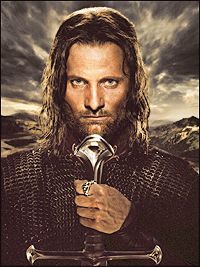 Anduril
was the sword of Aragorn. It was forged from
the shards of Elendil's sword, Narsil.
Anduril
was the sword of Aragorn. It was forged from
the shards of Elendil's sword, Narsil.
Narsil was made in the First Age by Telchar, the most renowned of the Dwarf-smiths of Nogrod in the Blue Mountains. The blade shone with the light of the Sun and the Moon.
Nothing is known about the sword's original owner or its early history. Narsil became the sword of Elendil, who escaped the downfall of Numenor and founded the Kingdoms of Gondor and Arnor in Middle-earth. Elendil wielded Narsil during the War of the Last Alliance, and the sword filled Sauron's forces with fear.
At the end of the war in 3441 of the Second Age, Sauron emerged from Barad-dur and fought with Elendil and Gil-galad. The two leaders of the Alliance were slain and Sauron was cast down. As Elendil fell, the blade of Narsil was broken into two pieces about a foot from the hilt and its light was extinguished. Elendil's son Isildur took up the hilt and with the shard of Narsil's blade he cut the One Ring from Sauron's hand, and Sauron's spirit fled from his body and went into hiding for many years.
Isildur kept the Ring and the shards of Narsil. Near the Gladden Fields in the year 2 of the Third Age, Isildur and his men were attacked by Orcs. Isildur entrusted the shards of Narsil to his esquire Ohtar and told him to save it at all costs. Ohtar and a companion fled, while Isildur and all but one other of his men were slain.
In the year 3, Ohtar brought the shards of Narsil to Isildur's only surviving son Valandil in Rivendell and they became a cherished heirloom of the heirs of Isildur. Elrond foretold that the sword would not be reforged until the One Ring was found and Sauron returned. When the North-kingdom ended and the Dunedain became a wandering people, the shards of Narsil were kept at Rivendell along with the other heirlooms of the House of Isildur.
Aragorn received the shards of Narsil at the age of 20 in 2951. At that time, Elrond told Aragorn of his heritage as the heir of Isildur. Aragorn bore the shards of Narsil in a sheath as he travelled throughout Middle-earth.
Aragorn revealed Narsil to Frodo Baggins when they met at the Prancing Pony on September 29, 3018. Frodo had received a letter from Gandalf that included a poem written by Bilbo Baggins mentioning the broken sword.
From the ashes a fire shall be woken,At the Council of Elrond on October 25, Aragorn again brought out the shards of Narsil after Boromir of Gondor told of the dream that had brought him to Rivendell: "Seek for the Sword that was broken: In Imladris it dwells..." (FotR, p. 259) Aragorn believed that the dream was a summons for him to bring the sword of Elendil back to Minas Tirith.
A light from the shadows shall spring;
Renewed shall be blade that was broken,
The crownless again shall be king.
The Fellowship of the Ring: "Strider," p. 182
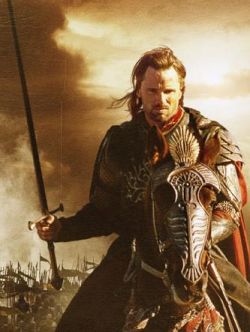
Anduril was the only weapon that Aragorn bore when he set out with the Fellowship of the Ring on December 25. In Moria on January 15, 3019, he used the blade to cleave the helmet of an Orc-chieftain who attacked Frodo with a spear.
When the Fellowship left Lothlorien on February 16, Galadriel gave Aragorn a sheath made especially for Anduril. The sword's name and lineage were written on it in Elven runes formed out of many gems and it was overlaid with flowers and leaves wrought of silver and gold. The sheath had the special property of protecting the blade that was drawn from it from being stained or broken in battle.
In Rohan on February 30, Aragorn revealed Anduril and his identity as Isildur's heir to Eomer, who was awed and cast down his eyes. Eomer agreed to help Aragorn, and he hoped that they would soon draw swords together.
When Aragorn arrived at Meduseld, he was reluctant to leave Anduril at the door of King Theoden's hall but at last he agreed to do so.
At the Battle of Helm's Deep on the night of March 3-4, Aragorn drew Anduril and Eomer unsheathed his sword Guthwine and they fought side by side. The Men of Rohan were inspired to see the sword that had been broken wielded in battle and their enemies were dismayed.
Aragorn looked into the palantir of Orthanc on March 6 and he showed Sauron that the sword that had cut the Ring from his hand had been forged anew, causing the Dark Lord to have doubt. Aragorn brought the sword of Elendil to Minas Tirith on March 15, arriving in the Corsairs' ships during the Battle of the Pelennor Fields. He led his reinforcements onto the battlefield and Anduril gleamed like fire kindled anew and it proved as deadly as Narsil of old.
After the Captains of the West decided to march to the Black Gate of Mordor to give Frodo time to complete his quest, Aragorn said that Anduril would not be sheathed until the last battle was fought. He wielded Anduril against the forces of Sauron in the Battle of the Morannon until the Ring was destroyed and the realm of Sauron was ended.
Names &
Etymology:
Narsil is composed of nar
meaning "fire" and thil meaning "white light." These same elements
are found in Anar - the Sun - and Isil (Quenya) or Ithil
(Sindarin) - the Moon. Narsil was said to shine with the light of the Sun
and the Moon.
Andúril means "Flame of the West." It is derived from andúnë meaning "sunset, west" and ril meaning "brilliance."
Also called the Blade that was Broken, the Sword that was Broken, the Sword of Elendil, and the Flame of the West.
Sources:
The Fellowship
of the Ring: "Strider," p. 182-84; "The Council of Elrond," p. 256-62;
"The Ring Goes South," p. 289-90, 292; "A Journey in the Dark," p. 312;
"The Bridge of Khazad-dum," p. 338-39; "Farewell to Lorien," p. 384, 391
The Two
Towers: "The Riders of Rohan," p. 36, 40, 42; "The White Rider," p.
98; "The King of the Golden Hall," p. 114-15; "Helm's Deep," p. 139-43
The Return
of the King: "The Passing of the Grey Company," p. 53-54; "The Battle
of the Pelennor Fields," p. 123; "The Last Debate," p. 158
Appendix
A of The Lord of the Rings: "The North-kingdom and the Dunedain," p.
323; "The Tale of Aragorn and Arwen," p. 338
The Silmarillion:
"Of the Rings of Power and the Third Age," p. 294-96, 303; "Appendix -
Elements in Quenya and Sindarin Names," entries for andúnë,
nar, ril, and sil
Unfinished
Tales: "The Disaster of the Gladden Fields," p. 272-73, 275
The Letters
of J.R.R. Tolkien: Letter #347
Eol reluctantly gave Anglachel to King Thingol of Doriath in exchange for permission to live in Nan Elmoth. When Beleg set out to find Thingol's foster son Turin* he requested a sword to bear along with his bow Belthronding. He chose Anglachel though Thingol's wife Melian warned him, "It will not love the hand it serves; neither will it abide with you long." (Sil, p. 202)
Beleg joined Turin who was living in the cave of Mim the Petty-Dwarf on Amon Rudh. In 489 of the First Age, Mim betrayed their location to Morgoth's spies and Turin was captured by Orcs. Beleg tracked the Orcs and found Turin unconscious. He used Anglachel to cut Turin's bonds and accidentally pricked Turin's foot with the blade. Turin awoke to see a figure standing over him in the dark with a sword and he seized Anglachel and unwittingly killed Beleg with it.
Beleg was buried with his bow, but the sword was given to Turin by Gwindor, an Elf of Nargothrond who had accompanied Beleg. Gwindor noted that Anglachel seemed to mourn Beleg's death as Turin did.
Turin went to Nargothrond around 490. Anglachel had become dull and blunt so the Elven-smiths reforged it and the edges of the black blade glowed with pale fire. Turin renamed the sword Gurthang, meaning "Iron of Death." Turin used Gurthang to fight Morgoth's forces and he became known as Mormegil, the Black Sword.
In 499, Turin slew Glaurung by thrusting Gurthang into the Dragon's soft underbelly. When he pulled out the sword, the Dragon's poisonous blood burned his hand and Glaurung opened his eyes with a look of malice, causing Turin to swoon. With his dying words, Glaurung told Turin's wife Niniel that she was really Turin's sister Nienor and she killed herself.
A man named Brandir told Turin what Glaurung had said but Turin thought he was lying and he killed Brandir with Gurthang. Turin then learned that the Dragon's words were true and he asked Gurthang to kill him.
And from the blade rang a cold voice in answer: "Yea, I will drink thy blood gladly, that so I may forget the blood of Beleg my master, and the blood of Brandir slain unjustly. I will slay thee swiftly." (Sil, p. 225)Turin fixed the hilt in the ground and fell on his sword. Gurthang broke beneath him and the shards were buried with Turin.
According to the Second Prophecy of Mandos (found in early versions of The Silmarillion but omitted from the published version) Turin will appear at Dagor Dagorath, the Last Battle, and he will slay Morgoth with his black sword.
Note:
In The
Silmarillion, Beleg is said to have received Anglachel after
he first found Turin with the outlaws but before he rejoined Turin in Mim's
cave. In a corrected timeline published in The
Children of Hurin, Beleg received Anglachel when he first set
out to find Turin.
Names &
Etymology:
The name Anglachel contains
the Sindarin words ang meaning "iron," lach meaning "leaping
flame," and el meaning "star." The name refers to the meteorite
from which the sword was made. Turin renamed it Gurthang meaning
"iron of death." The word gurth means "death."
The Men of the Forest of Brethil called it the Black Thorn of Brethil while Turin was living among them.
Sources:
The Silmarillion:
"Of Turin Turambar," p. 201-2, 206-11, 213-14, 216, 222, 224-26; "Appendix
- Elements in Quenya and Sindarin Names," entries for anga, el, gurth,
and lhach
Unfinished
Tales: "Narn I Hin Hurin," p. 110, 126, 128, 134-35, 137, 140-45
The Children
of Hurin: "Turin in Doriath," p. 96-97; "The Land of Bow and Helm,"
p. 141; "The Death of Beleg," p. 154-57; "Turin in Nargothrond," p. 160;
"The Fall of Nargothrond," p. 178, 180; "The Coming of Turin into Brethil,"
p. 194; "The Coming of Glaurung," p. 222, 226-27; "The Death of Glaurung,"
p. 237-39, "The Death of Turin," p. 248-49, 252-53, 256-57; "Appendix (2)
- The Composition of the Text," p. 286-87
The History
of Middle-earth, vol. IV, The Shaping of Middle-earth: "The Quenta,"
p. 165 (Turin at Dagor Dagorath)
The History
of Middle-earth, vol. XI, The War of the Jewels: "The Grey Annals,"
p. 82, 86, 92, 98-99, 101-3
Thingol's great-granddaughter Elwing gave the sword to her son Elros who became the first King of Numenor in the year 32 of the Second Age. Aranruth was passed down from ruler to ruler until the destruction of Numenor in 3319 when the sword was lost. It is not clear whether Aranruth was in Numenor when the island sank beneath the Sea or whether Ar-Pharazon took Aranruth with him when he attacked the Undying Lands. If the latter, then Aranruth would have been buried in the Caves of the Forgotten along with Ar-Pharazon until the Last Battle against Morgoth.
Names &
Etymology:
The name Aranrúth
means "King's Ire" in Sindarin from aran meaning "king" and rûth
meaning "anger."
Sources:
The Silmarillion:
"Of the Sindar," p. 94; "Of Turin Turambar," p. 201; Index, entry for Aranruth;
"Appendix - Elements in Quenya and Sindarin Names," entries for ar(a)
and ruth
Unfinished
Tales: "A Description of the Island of Numenor," p. 171 note 2; Index,
entry for Aranruth
Names &
Etymology:
The name Belthronding is
composed of bel meaning "strong, strength" and thrôn
meaning "stiff, hard" and ding meaning the sound a bowstring makes.
The word is Ilkorin, an early Elvish language developed by Tolkien for
the Elves of Beleriand which was replaced by Sindarin.
Sources:
The Silmarillion:
"Of Turin Turambar," p. 208
The Children
of Hurin: "Turin among the Outlaws," p. 112; "The Death of Beleg,"
p. 156
The History
of Middle-earth, vol. V, The Lost Road and Other Writings: "The Etymologies,"
entries for BEL, DING, and STAR/STARAN
When Smaug the Dragon attacked Lake-town in 2941 of the Third Age, Bard saved the Black Arrow for last. He learned from a thrush that there was a bare patch in the scales covering Smaug's underbelly. Bard shot the Black Arrow from his yew bow with such force that the barb, shaft, and feather penetrated the Dragon's body and killed him.
Source:
The Hobbit:
"Fire and Water," p. 261-62
Glamdring |
Gandalf
wields Glamdring in the New Line
film
|
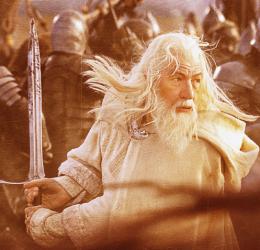 Sword
of Gandalf. Glamdring was forged in Gondolin,
a great realm of the Elves in the First Age. It once belonged to Turgon,
the King of Gondolin. It is not known how Glamdring survived the Fall of
Gondolin.
Sword
of Gandalf. Glamdring was forged in Gondolin,
a great realm of the Elves in the First Age. It once belonged to Turgon,
the King of Gondolin. It is not known how Glamdring survived the Fall of
Gondolin.
Six thousand years later, in the year 2941 of the Third Age, Gandalf found Glamdring in the Troll-hoard of Bert, Tom, and William in the Trollshaws. The swords Orcrist and Sting were also found in the Trolls' cave. Glamdring had a beautiful scabbard and a jewelled hilt and was engraved with runes. Elrond was able to identify the blade as Glamdring the Foe-hammer from the runes. A special property of the blade was that it glowed with blue light when Orcs were near.
When Thorin Oakenshield and company were attacked by Orcs in the Misty Mountains, Gandalf came to their rescue with a flash of fire and smoke. He used Glamdring to behead the Great Goblin. The other Orcs recognized the legendary sword, which they called Beater, and fled. Gandalf used Glamdring to cut the bonds of Bilbo and the Dwarves. Later, at the Battle of the Five Armies, it is likely that Gandalf used the sword against the attacking Orcs and Wargs.
Gandalf bore Glamdring when the Fellowship left Rivendell on December 25, 3018. In Moria, he wielded the sword in the battle against the Orcs in the Chamber of Mazarbul. On the Bridge of Khazad-dum, Gandalf confronted the Balrog with Glamdring. The blade glittered with white light and it shattered the Balrog's red sword into molten fragments. Gandalf then smote the bridge with his staff, and he and the Balrog fell into the abyss. Gandalf continued to fight the Balrog, hewing him with Glamdring until the Balrog fled up the Endless Stair. In the Battle of the Peak, Gandalf defeated the Balrog.
When he returned as Gandalf the White, he still had Glamdring. He left the sword in the care of Hama, the Doorward of Theoden at Meduseld. Gandalf later retrieved Glamdring and bore it throughout the War of the Ring. When Gandalf returned to Bree with the Hobbits in October of 3019 he was wearing the sword at his side. It is not known whether Gandalf took Glamdring with him when he left Middle-earth in September of 3021.
Names &
Etymology:
The name Glamdring comes
from the word Glamhoth, a Sindarin term for Orcs that literally
means "din horde" or "host of tumult." The word glam means "noise"
and the word dring means "beat, strike." Called Beater by
the Orcs and the Foe-hammer in the Common Speech.
Sources:
The Hobbit:
"Roast Mutton," p. 52-53; "A Short Rest," p. 62; "Over Hill and Under Hill,"
p. 75-76
The Fellowship
of the Ring: "The Ring Goes South," p. 293; "The Bridge of Khazad-dum,"
p. 338, 344-45
The Two
Towers: "The White Rider," p. 105; "The King of the Golden Hall," p.
115
The Return
of the King: "Homeward Bound," p. 272
Unfinished
Tales: "Of Tuor and His Coming to Gondolin," p. 54, note 18 (etymological
note only)
The History
of Middle-earth, vol. V, The Lost Road and Other Writings: "The Etymologies,"
entries for glam and dring
Encyclopedia
of Arda: Glamdring
entry
Great Horn |
Boromir
sounds the Great Horn in the New
Line film
|
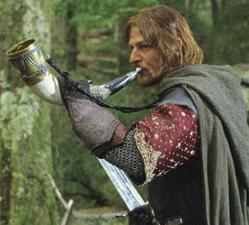 Horn
borne by the heirs of the Stewards of
Gondor.
Legend told that if the Great Horn was sounded in time of need within the
ancient boundaries of Gondor, it would not go unheeded.
Horn
borne by the heirs of the Stewards of
Gondor.
Legend told that if the Great Horn was sounded in time of need within the
ancient boundaries of Gondor, it would not go unheeded.
The Great Horn was made from the horn of a wild ox of Rhun. The ox was slain by Vorondil, a Steward of Gondor who lived from 1919 to 2029 of the Third Age. The Great Horn was bound and tipped with silver and carved with ancient runes. It was hung on a baldric, which is a long belt or strap worn across the chest from one shoulder. The voice of the horn was loud and clear and deep.
Boromir received the Great Horn from his father Denethor. It was his custom to sound the horn whenever he set out on a journey or to battle. He did so on December 25, 3018, when he left Rivendell as a member of the Fellowship. Elrond cautioned him not to sound the horn again unless he was in dire need.
At the Bridge of Khazad-dum on January 15, 3019, the sound of the Great Horn caused the Orcs and the Balrog to pause before they advanced on the Fellowship. Boromir again blew the horn at Amon Hen on February 26 while he tried to defend Merry and Pippin from a company of 100 Uruk-hai. The Uruk-hai drew back at the sound, but when no help came they attacked Boromir and killed him and carried Merry and Pippin away. The Great Horn was cloven in two by a sword or axe.
Aragorn, Legolas, and Gimli heard the Great Horn, but arrived too late to help Boromir. Boromir's father Denethor and his brother Faramir also heard the horn from afar in Minas Tirith, and it filled them with foreboding. The Great Horn was laid in the funeral boat of Boromir, but when Faramir saw the boat on February 29 he noticed that the horn was missing. The two pieces of the horn were retrieved from the Anduin: one was found among the reeds near the mouth of the Entwash and the other was found spinning in the flood on the water. The shards of the Great Horn were brought to Denethor who held them on his lap while waiting for news of his son.
Names &
Etymology:
The Great Horn has come to be called
the Horn of Gondor though it is not referred to this way in the
text of The Lord of the Rings. In the
text it is sometimes called the Horn of Boromir.
Sources:
The Fellowship
of the Ring: "The Council of Elrond," p. 253; "The Ring Goes South,"
p. 292; "The Bridge of Khazad-dum," p. 344
The Two
Towers: "The Departure of Boromir," p. 15-16, 19; "The Uruk-hai," p.
47; "The Window on the West," p. 273-74, 276, 287
The Return
of the King: "Minas Tirith," p. 27
At last, Fingolfin was overpowered and the pitted ground cause him to stumble, allowing Morgoth to break the High King's neck with his foot. Before he died, Fingolfin stabbed Morgoth's foot with his sword Ringil and hot black blood filled the pits that Grond had made. Morgoth survived but was later defeated in the War of Wrath at the end of the First Age. It is not known what became of Grond.
Names &
Etymology:
Also called the Hammer of the
Underworld. The word grond means "club" in Sindarin from
runda
meaning "a rough piece of wood." The battering ram Grond
that was used in the Siege of Gondor
was named after Morgoth's weapon.
Sources:
The Return
of the King: "The Siege of Gondor," p. 102
The Silmarillion:
"Of the Ruin of Beleriand," p. 154
The History
of Middle-earth, vol. V, The Lost Road and Other Writings: "The Etymologies,"
entry for RUD
The History
of Middle-earth, vol. XI, The War of the Jewels: "The Grey Annals,"
p. 55
Grond (II)Battering ram used by Sauron's forces during the Siege of Gondor. Grond was 100 feet long. Its head was made of black steel and was shaped like a ravening wolf.Grond was hung from large engines of war by mighty chains. It was pulled by Great Beasts and wielded by Mountain-trolls. The massive battering ram had been forged in the smithies of Mordor and spells of ruin were laid on it. Before dawn on March 15, 3019 of the Third Age, Grond was pulled across the Pelennor Fields to the Great Gate of Minas Tirith. The Trolls swung Grond against the iron doors but they withstood the blow. Then the Witch-king cried words of terror and power in an ancient tongue three times, and each time Grond was hurled against the Gate. The third time, Grond crashed through the Gate with a flash of light and the doors split asunder and fell to the ground in pieces. Names &
Etymology:
Sources:
|
Gúthwinë |
Guthwine
in the New Line film
|
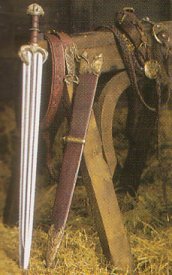 Sword
of Eomer. Eomer wielded Guthwine throughout the
War
of the Ring. Eomer had been imprisoned on the authority of Grima
Wormtongue, and when he was released he asked Hama
to bring Guthwine to him. Eomer offered his sword to Theoden,
and when the King grasped the hilt it seemed as though firmness and strength
returned to him.
Sword
of Eomer. Eomer wielded Guthwine throughout the
War
of the Ring. Eomer had been imprisoned on the authority of Grima
Wormtongue, and when he was released he asked Hama
to bring Guthwine to him. Eomer offered his sword to Theoden,
and when the King grasped the hilt it seemed as though firmness and strength
returned to him.
Eomer and Aragorn drew their swords together at the Battle of Helm's Deep and fought to defend the gates of the Hornburg.
The swords flashed from the sheath as one.At the Battle of the Pelennor Fields, when others despaired at the approach of the black-sailed ships of the Corsairs, Eomer raised Guthwine to defy them. But then he laughed and threw his sword into the air and sang as he caught it, for the standard of Aragorn was revealed on the foremost ship. The two friends met in the middle of the battlefield and leaned on their swords and were glad.
"Guthwine!" cried Eomer. "Guthwine for the Mark!"
"Anduril!" cried Aragorn. "Anduril for the Dunedain!"
The Two Towers: "Helm's Deep," p. 139
Names &
Etymology:
Gúthwinë means
"battle friend" from the Old English guð meaning "battle, war"
and winë meaning "friend."
Source:
The Two
Towers: "The King of the Golden Hall," p. 121-22; "Helm's Deep," p.
139
The Return
of the King: "The Battle of the Pelennor Fields," p. 123
| Sword of Theoden.
Herugrim was an ancient blade. Its scabbard was clasped with gold and was
set with green gems.
When Theoden fell under the influence of Grima Wormtongue, Grima took Herugrim and locked it in his chest. On March 2, 3019 of the Third Age, Gandalf healed Theoden and said, "Your fingers would remember their old strength better, if they grasped a sword-hilt." (TTT, p. 121) Theoden first accepted Eomer's sword Guthwine and then he asked that Herugrim be retrieved from Grima. Hama made Grima give him the keys to the chest where Herugrim was hidden, and then he knelt before the King and presented the sword to him. Theoden took Herugrim into the Battle of Helm's Deep and he wielded the sword at the Battle of the Pelennor Fields, where he was slain on March 15. Theoden's esquire Merry Brandybuck bore the King's arms in the funeral procession to Rohan. On August 10, Theoden was buried with his arms, but it is not stated whether Herugrim was among them. Names &
Etymology:
Sources:
|
Theoden
with Herugrim
in the New Line film 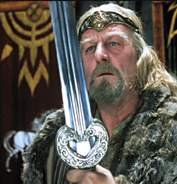 |
Horn of the Mark |
Decipher
card of the Horn of the Mark
|
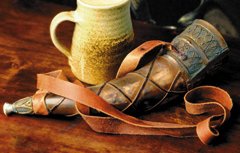 Horn
of Rohan given to Meriadoc
Brandybuck. The Horn of the Mark was given to Merry by Eowyn
in recognition of his service to Rohan during the War
of the Ring. It was silver with a baldric of green and it was engraved
with runes and with horsemen riding in a line winding from the mouth to
the tip. It had been brought to Rohan from the North by Eorl
the Young and had once been part of the hoard of
Scatha
the Worm. It was of Dwarf-make.
Horn
of Rohan given to Meriadoc
Brandybuck. The Horn of the Mark was given to Merry by Eowyn
in recognition of his service to Rohan during the War
of the Ring. It was silver with a baldric of green and it was engraved
with runes and with horsemen riding in a line winding from the mouth to
the tip. It had been brought to Rohan from the North by Eorl
the Young and had once been part of the hoard of
Scatha
the Worm. It was of Dwarf-make.
Merry sounded the Horn to rally the Hobbits before the Battle of Bywater. It became a tradition in Buckland to sound the Horn every November 2 at sundown, on the anniversary of the first time its call was heard in the Shire. Afterwards there would be bonfires and feasting.
Sources:
The Return
of the King: "Many Partings," p. 256; "The Scouring of the Shire,"
p. 286, 289, 295, 297
Appendix
D of The Lord of the Rings: p. 390
Merry's sword |
Merry
practices swordplay in the New
Line film
|
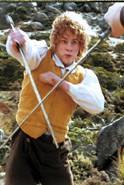 Sword
of
Meriadoc Brandybuck. Merry's sword played a
crucial role in the War of the Ring.
The sword came from a barrow on the
Barrow-downs
that may have been the grave of the last prince of Cardolan,
who was killed in battle against the forces of Angmar
in 1409 of the Third Age. The Hobbits were trapped in the barrow by a Barrow-wight
and when Merry awoke from the Barrow-wight's spell, he had a memory of
a Man who had fought the Witch-king of Angmar
long ago.
Sword
of
Meriadoc Brandybuck. Merry's sword played a
crucial role in the War of the Ring.
The sword came from a barrow on the
Barrow-downs
that may have been the grave of the last prince of Cardolan,
who was killed in battle against the forces of Angmar
in 1409 of the Third Age. The Hobbits were trapped in the barrow by a Barrow-wight
and when Merry awoke from the Barrow-wight's spell, he had a memory of
a Man who had fought the Witch-king of Angmar
long ago.
Tom Bombadil rescued the Hobbits and gave them blades from the barrow. The swords had been made for the war against the Witch-king of Angmar by the Dunedain of Arnor and they were wound with spells against the servants of Sauron. They were long, leaf-shaped daggers damasked with serpents in red and gold, and they had black sheaths of light metal set with fiery stones.
Merry used the sword in Moria and at Amon Hen, where he managed to cut off the hands and arms of several Orcs before he and Pippin were captured. He laid the sword on the lap of King Theoden of Rohan when he became his esquire.
But the final and most important time that Merry used the sword was at the Battle of the Pelennor Fields. As Eowyn confronted the Witch-king and was nearly slain, Merry pierced the sinew of the Witch-king's knee, causing the Nazgul to stumble forward. Eowyn then thrust her sword between the Witch-king's crown and mantle and he was vanquished. Afterwards, the blade of Merry's sword disintegrated.
So passed the sword of the Barrow-downs, work of Westernesse. But glad would he have been to know its fate who wrought it slowly long ago in the North-kingdom when the Dunedain were young, and chief among their foes was the dread realm of Angmar and its sorcerer king. No other blade, not though mightier hands had wielded it, would have dealt that foe a wound so bitter, cleaving the undead flesh, breaking the spell that knit his unseen sinews to his will.Names & Etymology:
The Return of the King: "The Battle of the Pelennor Fields," p. 119-20
Sources:
The Fellowship
of the Ring: "Fog on the Barrow-downs," p. 157
The Two
Towers: "The Departure of Boromir," p. 17; "The Uruk-hai," p. 47
The Return
of the King: "The Passing of the Grey Company," p. 50-51; "The Battle
of the Pelennor Fields," p. 115-17
Appendix
A of The Lord of the Rings: "The North-kingdom and the Dunedain," p.
321
Mithril shirt |
Coat
of mithril-mail from the New Line
Film
designed by Daniel Falconer |
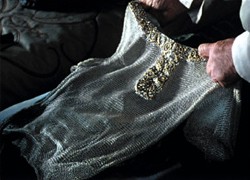 Coat
of mail belonging to Bilbo Baggins. It was given
to Bilbo by Thorin Oakenshield from the hoard
of Smaug the Dragon. Given its small
size, it was probably made for a young Elf prince. It was a corslet made
of rings of mithril - a rare precious
metal sometimes called
true silver that was beautiful yet harder
than steel. The shirt was studded with white gems and was girt with a belt
of pearl and crystal. It felt light to the wearer but was strong enough
to turn any blade. The value of the shirt was more than that of the entire
Shire.
Coat
of mail belonging to Bilbo Baggins. It was given
to Bilbo by Thorin Oakenshield from the hoard
of Smaug the Dragon. Given its small
size, it was probably made for a young Elf prince. It was a corslet made
of rings of mithril - a rare precious
metal sometimes called
true silver that was beautiful yet harder
than steel. The shirt was studded with white gems and was girt with a belt
of pearl and crystal. It felt light to the wearer but was strong enough
to turn any blade. The value of the shirt was more than that of the entire
Shire.
Bilbo wore the mithril shirt during the Battle of the Five Armies in 2941 of the Third Age. On his return to the Shire, he hung it on a stand in his hall for a while and then gave it to the Mathom-house in Michel Delving. He retrieved it from the museum and took it with him when he left the Shire in 3001.
Bilbo gave the mithril shirt to Frodo Baggins in 3018 when he embarked on his quest to destroy the One Ring. In Moria, the mail saved Frodo life when he was hit by a spear during the battle in the Chamber of Mazarbul. His companions were amazed that he had survived. Aragorn remarked, "That spear-thrust would have skewered a wild boar!" (FotR, p. 342) Later, when his mithril shirt was revealed, it was found that the spear had left only bruises.
When Sam Gamgee believed Frodo to be dead outside Shelob's Lair, he left the mithril shirt with Frodo. Frodo was taken to the Tower of Cirith Ungol by the Orcs Shagrat and Gorbag, who stripped the shirt from Frodo and fought over it. Most of the Orcs in the Tower were killed in the fight, allowing Sam to enter the Tower. But Shagrat escaped with the mithril shirt, and Sam let him go in order to seek Frodo. Shagrat brought the coat of mail to Barad-dur on March 17. On March 25, the Mouth of Sauron showed the mithril shirt, along with Frodo's Elven cloak and Sam's sword, to the Host of the West at the Black Gate.
"Dwarf-coat, elf-cloak, blade of the downfallen West, and spy from the little rat-land of the Shire - nay, do not start! We know it well - here are the marks of a conspiracy. Now, maybe he that bore these things was a creature that you would not grieve to lose, and maybe otherwise: one dear to you, perhaps? If so, take swift counsel with what little wit is left to you. For Sauron does not love spies, and what his fate shall be depends now on your choice."Gandalf took the mitrhil-mail and other tokens back from the Mouth of Sauron and denied Sauron's terms of surrender. The Host of the West fought the forces of Mordor in the Battle of the Morannon until the Ring-bearer fulfilled his quest and the Enemy was defeated.
The Return of the King: "The Black Gate Opens," p. 166
Frodo wore the mithril shirt at the celebrations on the Field of Cormallen as well as on the trip home. The corslet saved his life one more time when Saruman, who had taken over the Shire in the Hobbits' absence, tried to stab Frodo after Frodo had spared his life. Saruman was then killed by Grima. It is likely that the mithril shirt was passed on to Sam Gamgee, who inherited all of Frodo's possessions when Frodo left Middle-earth.
Names &
Etymology:
Mithril is Sindarin meaning
"grey glitter."
Sources:
The Hobbit:
"Not at Home," p. 252; "The Last Stage," p. 316
The Fellowship
of the Ring: "The Ring Goes South," p. 290-91; "A Journey in the Dark,"
p. 331; "The Bridge of Khazad-dum," p. 339-42; "Lothlorien," p. 350-51
The Two
Towers: "The Choices of Master Samwise," p. 340
The Return
of the King: "The Black Gate Opens," p. 165-67; "The Tower of Cirith
Ungol," 182-84; "The Field of Cormallen," p. 233; "The Scouring of the
Shire," p. 299
The History
of Middle-earth, vol. V, The Lost Road and Other Writings: "The Etymologies,"
entries for MITH and RIL
Morgul-knife |
The
Morgul-knife in the New Line Film
|
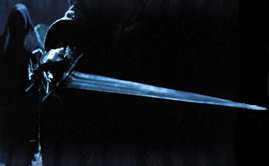 Weapon
of the Lord of the Nazgul. The blade of the
Morgul-knife was long and thin and it glowed with a pale light. On the
hilt were hidden evil writings.
Weapon
of the Lord of the Nazgul. The blade of the
Morgul-knife was long and thin and it glowed with a pale light. On the
hilt were hidden evil writings.
The Lord of the Nazgul stabbed Frodo Baggins with the Morgul-knife during the attack on Weathertop on October 6, 3018 of the Third Age. The point of the blade broke off in Frodo's left shoulder and began working its way toward his heart. Frodo became gravely ill; his shoulder and arm became cold and numb, and his vision was clouded. In time, Frodo would have become a wraith under the dominion of Sauron.
The sliver remained in Frodo's body for seventeen days, until Elrond was able to remove it on October 23. Frodo recovered to a certain extent, but the wound continued to trouble him for as long as he remained in Middle-earth, especially each year on the anniversary of the attack. Gandalf noticed a hint of transparency about Frodo, particulary in the arm that had been wounded.
The blade of the Morgul-knife disintegrated in the morning light the day after Frodo was wounded. Aragorn chanted over the hilt in a strange language and brought it to Rivendell. The sliver that was removed from Frodo's shoulder was melted.
Names &
Etymology:
The word morgul means "black
sorcery." The element
mor means "black, dark." The element gûl
means
"sorcery, magic" from the stem ngol or nólë meaning
"long study, lore, knowledge."
Sources:
The Fellowship
of the Ring: "A Knife in the Dark," p. 208; "Flight to the Ford," p.
209-11, 215, 223; "Many Meetings," p. 233-35
The Return
of the King: "Homeward Bound," p. 268; "The Grey Havens," p. 305
The Silmarillion:
"Appendix - Elements in Quenya and Sindarin Names," entries for mor,
and gul
Orcrist was forged in Gondolin, a great realm of the Elves in the First Age. It was a famous blade and had been used to slay many Orcs. The name Orcrist meant "Goblin-cleaver" and Orcs hated and feared it and called it Biter. The original owner of Orcrist is not known, nor is it known how the sword escaped the Fall of Gondolin.
In the year 2941 of the Third Age, Thorin Oakenshield found Orcrist in the Troll-hoard of Tom, Bert and William in the Trollshaws. Glamdring and Sting were found in the same hoard. Elrond later identified Orcrist from its runes. When Thorin learned of the sword's history he said, "I will keep this sword in honour. May it soon cleave goblins once again!" (Hobbit, p. 62)
The Orcs who captured the Dwarves in the Misty Mountains recoginized Thorin's sword as Biter, and they would have slain the Dwarves in their hatred and rage had not Gandalf come to the rescue. Gandalf retrieved Orcrist from the Orcs and Thorin wielded the sword as they fought to escape.
Orcrist was taken from Thorin when he was captured by the Wood-Elves in Mirkwood. After Thorin was slain in the Battle of the Five Armies, the Elvenking laid Orcrist upon his tomb. It was said that ever after the blade gleamed in warning when foes approached the Lonely Mountain.
Names &
Etymology:
Orcrist is translated as
"Goblin-cleaver." The element ris or rista means "cut, cleave."
Called Biter by the Orcs and the Goblin-cleaver in the Common
Speech.
Sources:
The Hobbit:"Roast
Mutton," p. 52-53; "A Short Rest," p. 62; "Over Hill and Under Hill," p.
74-76; "Out of the Frying-Pan into the Fire," p. 103; "A Warm Welcome,"
p. 208; "The Return Journey," p. 303
The Fellowship
of the Ring: "The Ring Goes South," p. 293
The History
of Middle-earth, vol. V, The Lost Road and Other Writings:
"The Etymologies," entries for RIS
Red ArrowToken used to summon the Rohirrim to the aid of Gondor. The Red Arrow had a steel head with the point painted red, and there were black feathers on its shaft. In time of war, the Red Arrow was sent by the Steward of Gondor to the King of Rohan to indicate that Gondor needed Rohan's help.On March 9, 3019 of the Third Age, a messenger of Gondor named Hirgon brought the Red Arrow to King Theoden at Duharrow, saying: "Hirgon I am, errand-rider of Denethor, who bring you this token of war. Gondor is in great need. Often the Rohirrim have aided us, but now the Lord Denethor asks for all your strength and all your speed, lest Gondor fall at last."King Theoden oversaw the Muster of Rohan the next day. He rode to Gondor with 6,000 Rohirrim and fought in the Battle of the Pelennor Fields on March 15. Source:
|
Decipher
card of the Red Arrow
|
Fingolfin wounded Morgoth seven times with Ringil. Morgoth finally overpowered Fingolfin and broke his neck, but before he died, Fingolfin cut deeply into Morgoth's foot with his sword. Morgoth became permanently lame, and the pain of the wounds inflicted by Ringil did not heal.
Fingolfin's body was buried under a cairn in the Encircling Mountains, but it is not known what became of Ringil.
Names &
Etymology:
The name Ringil contains
the word ringë meaning "cold" because the sword "glittered
like ice."
Sources:
The Silmarillion:
"Of the Ruin of Beleriand," p. 155-56
The History
of Middle-earth, vol. V, The Lost Road and Other Writings: "The Etymologies,"
entry for RINGI
The swords were long, leaf-shaped daggers. They were made of a light, strong metal, set with gems and damasked with serpents in red and gold. There was Numenorean writing on the blades and they were wound with spells against the servants of Sauron. The swords were well made and remained sharp and free of rust after centuries in the barrow.
Sam killed an Orc with his sword in the Chamber of Mazarbul in Moria on January 15, 3019. On March 13, Frodo was stung by Shelob and Sam believed him to be dead. Sam took Frodo's sword Sting and left his own Barrow-blade beside his master. Sam's sword was found by the Orcs who captured Frodo.
Sam's sword and Frodo's cloak and mithril shirt were taken to Barad-dur. On March 25, the Mouth of Sauron showed the sword, cloak and mail to Gandalf and the Host of the West as proof that a Hobbit had been captured. Gandalf took the items from the Mouth of Sauron.
After Frodo and Sam were rescued from Mordor, Sam's sword was returned to him at the Field of Cormallen. He used the sword in the Battle of Bywater on November 3.
Names &
Etymology:
The swords from the barrows are
referred to as swords of Westernesse because they were made by the
descendants of the Men of Numenor, which was also called Westernesse. They
were also called Barrow-blades.
Sources:
The Fellowship
of the Ring: "Fog on the Barrow-downs," p. 157; "A Journey in the Dark,"
p. 312; "The Bridge of Khazad-dum," p. 339
The Two
Towers: "The Departure of Boromir," p. 17; "The Passage of the Marshes,"
p. 230; "The Black Gate Is Closed," p. 254; "Of Herbs and Stewed Rabbit,"
p. 265; "The Window on the West," p. 289; "Shelob's Lair," p. 328, 330-31,
335-36; "The Choices of Master Samwise," p. 340
The Return
of the King: "The Black Gate Opens," p. 165-68; "The Field of Cormallen,"
p. 233; "The Scouring of the Shire," p. 285, 299
Sting |
Frodo
with Sting in the New Line film
|
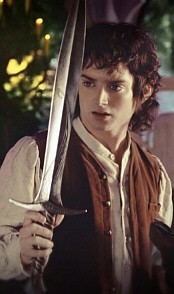 Sword
of Bilbo Baggins. Sting was actually a long knife
that made the perfect Hobbit-sized sword. Bilbo found it in 2941 of the
Third Age in the
Troll-hoard of Bert,
Tom and William, where the swords Glamdring and
Orcrist
were also found. These three blades were made by the Elves in Gondolin
in the First Age.
Sword
of Bilbo Baggins. Sting was actually a long knife
that made the perfect Hobbit-sized sword. Bilbo found it in 2941 of the
Third Age in the
Troll-hoard of Bert,
Tom and William, where the swords Glamdring and
Orcrist
were also found. These three blades were made by the Elves in Gondolin
in the First Age.
A special property of the blades was that they glowed with a blue light when Orcs were near. Bilbo used the faint light from the sword to make his way through the tunnels of the Misty Mountains after he was separated from his Dwarf companions. He encountered the creature Gollum and considered using the sword to kill him but decided to spare him out of pity.
Bilbo first used his sword to kill the Great Spiders in Mirkwood who captured him and his friends. It was then that he named the sword Sting.
Somehow the killing of the giant spider, all alone by himself in the dark without the help of the wizard or the dwarves or of anyone else, made a great difference to Mr. Baggins. He felt a different person, and much fiercer and bolder in spite of an empty stomach, as he wiped his sword on the grass and put it back into its sheath.When he returned home, Bilbo hung Sting over his mantlepiece. He took it with him when he left the Shire in 3001. On December 25, 3018, Bilbo gave the sword to Frodo Baggins, who was about to embark on his quest to destroy the One Ring.
"I will give you a name," he said to it, "and I shall call you Sting."
The Hobbit: "Flies and Spiders," p. 167
Frodo first used the sword in Moria to stab the foot of a Cave-troll. When Gollum attacked Sam Gamgee in the Emyn Muil, Frodo drew Sting and put it to the creature's throat. But, like Bilbo, Frodo decided to spare Gollum's life.
In Shelob's Lair, Frodo drew Sting and the Phial of Galadriel and advanced on Shelob, causing her to retreat. He used the sword to cut through the spiderwebs blocking their escape, but Shelob caught up to Frodo and stung him. Sam took up Sting in his left hand and cut off one of Shelob's claws and he put out one of her eyes with his own sword. He slashed at her abdomen with Sting, and then, as the creature lowered her weight onto him, Sam held up Sting and it pierced her belly, wounding her terribly and possibly fatally.
Sam believed Frodo to be dead, and he took Sting from him along with the Ring intending to continue the quest alone. When he discovered his mistake, Sam rescued Frodo from the Tower of Cirith Ungol. The Orcs mistook Sam, armed with Sting, for a great Elf-warrior. Frodo then gave Sting to Sam to keep, saying, "I do not think it will be my part to strike any blow again." (RotK, p. 204)
When Sam jettisoned their gear on the plain of Gorgoroth he kept Sting, and the sword was saved from the destruction of Mordor by Gandalf. At the Field of Cormallen, Frodo was reluctant to wear any sword, and would have preferred to take the sword that belonged to Sam, but Sam insisted that Frodo wear Sting for the celebrations. It is likely that Frodo returned Sting to Sam, to whom he left all his possessions on leaving Middle-earth.
Sources:
The Hobbit:"Roast
Mutton," p. 52-3; "A Short Rest," p. 62; "Riddles in the Dark," p. 80,
97; "Flies and Spiders," p. 166-76, "The Last Stage," p. 316
The Fellowship
of the Ring: "The Ring Goes South," p. 290; "The Bridge of Khazad-dum,"
p. 339
The Two
Towers: "The Taming of Smeagol," p. 221-22; "Shelob's Lair," 330-32;
"The Choices of Master Samwise," p. 337-42
The Return
of the King: "The Tower of Cirith Ungol," p. 189; "The Land of Shadow,"
p. 204; "Mount Doom," p. 215; "The Field of Cormallen," p. 233
"Troll's Bane" (Pippin's sword) |
Pippin
practices swordplay in the New
Line Film
|
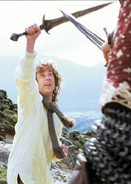 Nickname
of the sword of Peregrin Took. Pippin and his
companions were given swords by Tom
Bombadil on the Barrow-downs.
The swords came from a barrow that may have been the grave of the last
prince of Cardolan, who was killed in battle against
the forces of Angmar in 1409 of the Third
Age.
Nickname
of the sword of Peregrin Took. Pippin and his
companions were given swords by Tom
Bombadil on the Barrow-downs.
The swords came from a barrow that may have been the grave of the last
prince of Cardolan, who was killed in battle against
the forces of Angmar in 1409 of the Third
Age.
The swords had been made for the war against the Witch-king of Angmar by the Dunedain of Arnor and they were wound with spells against the servants of Sauron. They were long, leaf-shaped daggers damasked with serpents in red and gold and engraved with characters of Numenor, and they had black sheaths of light metal set with fiery stones.
Pippin used his sword to pledge fealty to Denethor, Steward of Gondor. At the Battle of the Morannon, Pippin slew a great Troll-chief with it, saving his friend Beregond's life. The sword's true name is not known, but during the Scouring of the Shire, Pippin called it "Troll's bane."
"I am a messenger of the King," he said. "You are speaking to the King's friend, and one of the most renowned in all the lands of the West. You are a ruffian and a fool. Down on your knees in the road and ask pardon, or I will set this troll's bane in you!"Names & Etymology:
The Return of the King: "The Scouring of the Shire," p. 285
Sources:
The Fellowship
of the Ring: "Fog on the Barrow-downs," p. 157
The Two
Towers: "The Departure of Boromir," p. 17
The Return
of the King: "Minas Tirith," p. 28; "The Black Gate Opens," p. 168-69;
"The Scouring of the Shire," p. 285
Appendix
A of The Lord of the Rings: "The North-kingdom and the Dunedain," p.
321
All entries are Copyright © by the Thain from former tuckborough.net. Please contact me if you are Thain or know anything about how to contact the original author.
2003-2011, The Thain's Book - thainsbook.minastirith.cz
- e-mail: thain at tuckborough.net